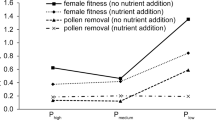Summary
Under conditions where resources are limited, there are often negative correlations between components of maternal yield, or between fruit and flower production. Pollination, in turn, may vary among individuals and influence total maternal expenditure. We examined the impact of variation in pollination thoroughness upon yield components and overall plant growth in wild radish (R. raphanistrum) plants grown in the greenhouse. Plants received different pollination treatments in which 0% to 100% of all flowers produced were hand-pollinated. Fruit set was increased by hand-pollination, but rarely exceeded 30%, even when more than 50% of the flowers were pollinated. Plants receiving more thorough pollination or having greater proportion fruit set produced significantly smaller seeds. Seed number per fruit was not influenced by pollination treatment. Mean values of yield components and interactions between components often varied among plants from different maternal families. Increasing pollination thoroughness also resulted in dramatic decreases in flower production. If male fitness is related to flower number, there may be a tradeoff between maternal fecundity and successful pollen export operating at the whole-plant level in this species.
Similar content being viewed by others
References
Adams MW (1967) Bases of yield component compensation in crop plants with special reference to the field bean, Phaseolus vulgaris. Crop Sci 7:505–510
Antonovics J (1978) The nature of limits to natural selection. Ann Mo Bot Gard 63:224–247
Baker GA, Brooks RM (1947) Effects of fruit thinning on almond fruits and seeds. Bot Gaz 108:550–556
Bierzychudek P (1981) Pollinator limitation of plant reproductive effort. Am Natur 117:838–840
Binnie RC, Clifford PE (1981) Flower and pod production in Phaseolus vulgaris. J Agric Sci Camb 97:397–402
Casper BB (1984) On the evolution of embryo abortion in the herbaceous perennial Cryptantha flava. Evolution 38:1332–1349
Chan BG, Cain JC (1967) The effect of seed formation on subsequent flowering in apple. Proc Amer Soc Hort Sci 91:63–68
Charnov EL (1982) The theory of sex allocation. Princeton University Press, Princeton, NJ
Colosi JC, Cavers PB (1984) Pollination affects percent biomass allocated to reproduction in Silene vulgaris (bladder campion). Am Natur 124:299–306
Davies PJ, Proebsting WM, Gianfagna TJ (1977) Hormonal relationships in whole plant senescence. In: Pilet PE (ed) Plant growth regulation. Springer, Berlin, Heidelberg, New York
Devlin B (1986) Studies on the male and female reproductive functions with a hermaphroditic species, Lobelia cardinalis. PhD dissertation, Pennsylvania State University
Freund RJ, Littel RC (1981) SAS for linear models. SAS Institute, Cary, N.C.
Galen C (1985) Regulation of seed-set in Polemonium viscosum: floral scents, pollination, and resources. Ecology 66:792–797
Goldschmidt EE, Golomb A (1982) The carbohydrate balance of alternate-bearing citrus trees and the significance of reserves for flowering and fruiting. J Am Soc Hort Sci 107:206–208
Hainsworth FR, Wolf LL, Mercier T (1985) Pollen limitation in a monocarpic species, Ipomopsis aggregata. J Ecol 73:263–270
Holm L, Pancho JV, Herberger JP, Plucknett DL (1979) A geographical atlas of world weeds. Wiley and Sons Publishing, N.Y.
Holtsford TP (1985) Nonfruiting hermaphroditic flowers of Calochortus leichtlinii (Liliaceae): potential reproductive functions. Am J Bot 72:1687–1694
Imaseki H (1985) Hormonal control of wound-induced responses. In: Pharis RP Reid DM (eds) Hormonal regulation of development III, Role of environmental factors. Springer, Berlin, Heidelberg New York, pp 485–512
Kay QON (1976) Preferential pollination of yellow-flowered morphs of Raphanus raphanistrum by Pieris and Eristalis spp. Nature (Lond) 261:230–232
Lee TD (1984) Patterns of fruit maturation: a gametophytic competition hypothesis. Am Natur 123:427–432
Lee TD (1987) Patterns of fruit and seed production. In: Lovett Doust J, Lovett Doust L (eds) Reproductive ecology of plants. Oxford Univ. Press, Oxford (in press)
Lloyd DG (1980) Sexual strategies in plants. I. An hypothesis of serial adjustment of maternal investment during one reproductive session. New Phytol 86:69–79
Lloyd DG (1984) Gender allocations in outcrossing cosexual plants. In: Dirzo R, Sarukhan J (eds) Perspectives on plant population ecology. Sinauer, Sunderland, MA, pp 277–300
Lovett Doust J, Eaton GW (1982) Demographic aspects of flower and fruit production in bean plants, Phaseolus vulgaris L. Am J Bot 69:1156–1164
Marshall DL, Levin DA, Fowler NL (1985) Plasticity in yield components in response to fruit predation and data of fruit initiation in three species of Sesbania (Leguminosae). J Ecol 73:71–80
Marshall DL, Levin DA, Fowler NL (1986) Plasticity of yield components in response to stress in Sesbania macrocarpa and Sesbania vesicaria (Leguminosae). Am Natur 127:508–521
Mazer SJ (1986) Causes and consequences of seed weight variation in Raphanus raphanistrum (Brassicaceae): a quantitative genetic approach. PhD dissertation, University of California, Davis, CA
Mazer SJ (1987) The quantitative genetics of life-history and fitness components in Raphanus raphanistrum: ecological and evolutionary consequences of seed weight variation. Am Natur (in press)
Mazer SJ, Snow AA, Stanton ML (1986) Fertilization dynamics and parental effects upon fruit development in Raphanus raphanistrum: consequences for seed weight variation. Am J Bot 73:500–511
Nakamura RR (1986) Maternal investment and fruit abortion in Phaseolus vulgaris. Am J Bot 73:1049–1057
Nickell CD, Grafius JE (1969) Analysis of a vegetative response to selection for high yield in a winter barley. Crop Sci 9:447–451
Ojehomon OO (1970) Effect of continuous removal of open flowers on the seed yield of two varieties of cowpea, Vigna unguiculata (L.) Walp. J Agric Sci Camb 74:375–381
Pederson MW, Peterson HL, Bohart GE, Levin MD (1956) A comparison of the effect of complete and partial cross-pollination of alfalfa on pods set, seeds per pod, and pod and seed weight. Agron J 48:177–180
Queller DC (1983) Sexual selection in a hermaphroditic plant. Nature (Lond) 305:706–707
Sampson DR (1964) A one-locus self-incompatibility system in Raphanus raphanistrum. Canad J Genet Cytol 6:435–445
Schaffer AA, Goldschmidt EE, Goren R, Galili D (1985) Fruit set and carbohydrate status in alternate and nonalternate bearing citrus cultivars. J Am Soc Hort Sci 110:574–578
Silander JA (1978) Density-dependent control of reproductive success in Cassia biflora. Biotropica 10:292–296
Snow AA (1982) Pollination intensity and potential seed set in Passiflora vitifolia. Oecologia (Berlin) 55:231–237
Sparks D, Madden G (1985) Pistillate flower and fruit abortion in Pecan as a function of cultivar, time, and pollination. J Am Soc Hort Sci 110:219–223
Stanton ML (1984) Seed variation in wild radish: Effect of seed size on components of seedling and adult fifness. Ecology 65:1105–1112
Stanton ML, Snow AA, Handel SN (1986) Floral evolution: attractiveness to pollinators increases male fitness. Science 232:1625–1627
Stephenson AG (1981) Flower and fruit abortion: proximate causes and ultimate functions. Ann Rev Ecol Syst 12:253–279
Stephenson AG (1984) The regulation of maternal investment in an indeterminate flowering plant (Lotus corniculatus). Ecology 65:113–123
Stephenson AG, Winsor JA (1986) Lotus corniculatus regulates offspring quality through selective seed abortion. Evolution 40:453–458
Sutherland S, Delph LF (1984) On the importance of male fitness in plants: patterns of fruit set. Ecology 65:1093–1104
Tamas IA, Ozbun JL, Wallace DH, Powell LE, Engels CJ (1979) Effects of fruits on dormancy and abscissic acid concentration in the axillary buds of Phaseolus vulgaris L. Plant Physiol 64:615–619
Thomson JD, Maddison WP, Plowright RC (1982) Behavior of bumble bee pollinators on Aralia hispida Vent. (Araliaceae). Oecologia (Berlin) 54:326–336
Van Steveninck RFM (1957) Factors affecting the abscission of reproductive organs in yellow lupins (Lupinus luteus L.), Part 1, The effect of different patterns of flower removal. J Exp Bot 8:373–381
Waser NM, Price MV (1981) Pollinator choice and stabilizing selection for flower color in Delphinium nelsonii. Evolution 35:376–390
Willson MF (1983) Plant reproductive ecology. Wiley, N.Y.
Willson MF, Bertin RI (1979) Flower-visitors, nectar production, and inflorescence size of Asclepias syriaca. Canad J Bot 57:1380–1388
Willson MF, Burley N (1983) Mate choice in plants. Princeton Univ. Press, Princeton, N.J.
Willson MF, Price PW (1977) The evolution of inflorescence size in Asclepias (Asclepiadaceae). Evolution 31:495–511
Willson MF, Price PW (1980) Resource limitation of fruit and seed production in some Asclepias species. Canad J Bot 58:2229–2233
Author information
Authors and Affiliations
Rights and permissions
About this article
Cite this article
Stanton, M.L., Bereczky, J.K. & Hasbrouck, H.D. Pollination thoroughness and maternal yield regulation in wild radish, Raphanus raphanistrum (Brassicaceae). Oecologia 74, 68–76 (1987). https://doi.org/10.1007/BF00377347
Received:
Issue Date:
DOI: https://doi.org/10.1007/BF00377347




